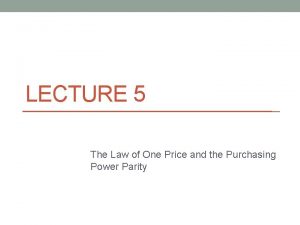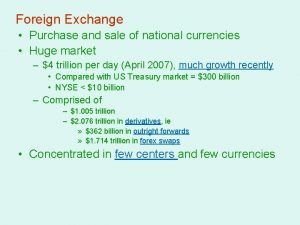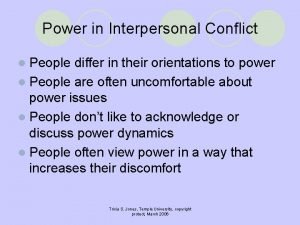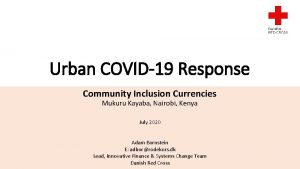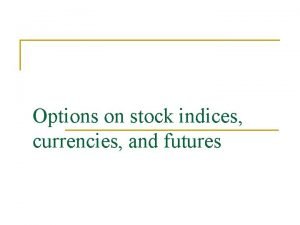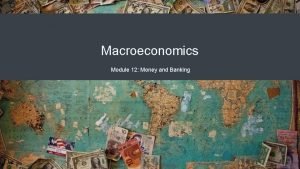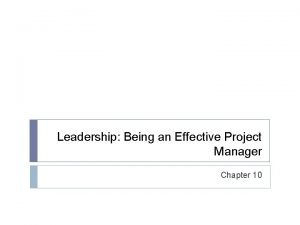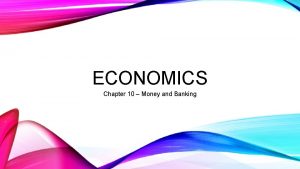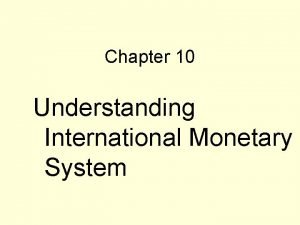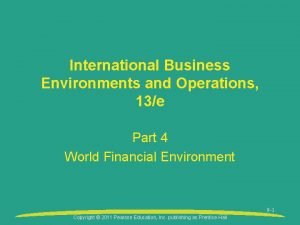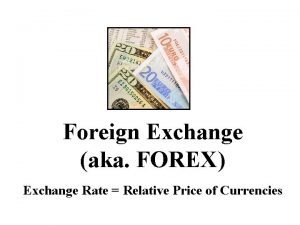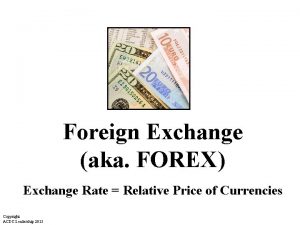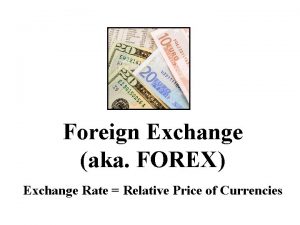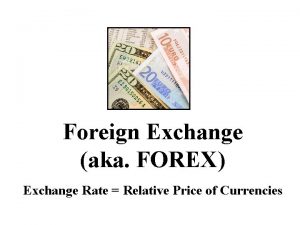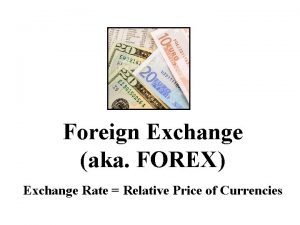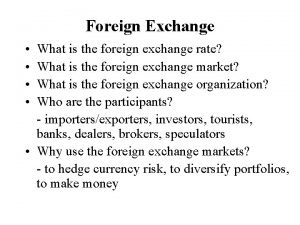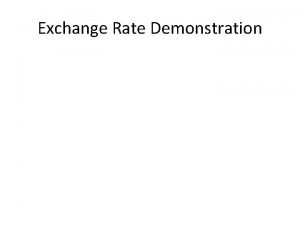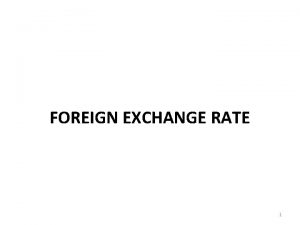Foreign Exchange Rate Relative Price of Currencies Exports













- Slides: 13

Foreign Exchange Rate = Relative Price of Currencies

Exports and Imports 1. US sells cars to Mexico 2. Mexico buys tractors from Canada 3. Canada sells syrup t the U. S. 4. Japan buys Fireworks from Mexico For all these transactions, there are different national currencies. Each country must be paid in their own currency The buyer (importer) must exchange their currency for that of the sellers (exporter).

The turnover in FOREX markets is almost $4 trillion (USD) a day Currency Codes USD = US Dollar EUR = Euro JPY = Japanese Yen GBP = British Pound CHF = Swiss Franc CAD = Canadian Dollar AUD = Australian Dollar NZD = New Zealand Dollar

Exchange Rates In the FOREX market we only look at two countries/currencies at a time. Ex: US Dollars and British Pounds We examine the price of one currency in terms of the other currency. Ex: $2 = £ 1 The Exchange Rate depends on which currency you are converting. The price of one US Dollar in terms of Pounds is 1 Dollar = £ 1/$2 = £. 5 The price of one Pound in terms of Dollars is 1 Pound = $2/£ 1 = $2

What happens if you need more dollar to buy one pound (the price for a pound increases)? Ex: From $2=£ 1 to $5=£ 1 • The U. S. Dollar DEPRECIATES relative to the Pound. Depreciation • The loss of value of a country's currency with respect to a foreign currency • More units of dollars are needed to buy a single unit of the other currency. • The dollar is said to be “Weaker”

What happens if you need less dollar to buy one pound (the price for a pound decreases)? Ex: From $2=£ 1 to $1=£ 4 • The U. S. Dollar APPRECIATES relative to the Pound. Appreciation • The increase of value of a country's currency with respect to a foreign currency • Less units of dollars are needed to buy a single unit of the other currency. • The dollar is said to be “Stronger”

Price of US Dollars S&D for the US Dollars Pound£ Dollar$ Equilibrium: $1 = £ 1 Supply by Americans 2£/1$ 1£/1$ US Dollar appreciates US Dollar depreciates 1£/4$ Demand by British Quantity of US Dollars Q

Exchange Rates Currency Shifters 1. Changes in Tastes. Ex: British tourists flock to the U. S Demand for U. S. dollar increases Supply of British pounds in the exchange market increases Pound-depreciates Dollar-appreciates

Exchange Rates 2. Changes in Relative Incomes (Resulting in more imports) Ex: US growth increase income…. U. S. increases buys more imports… Demand for pound increases Supply of U. S. dollars increases Pound- appreciates Dollar- depreciates

Exchange Rates 3. Changes in Relative Price Level (Resulting in more imports) Ex: US prices increase relative to Britain…. Demand for cheaper imports increases… Demand for pound increases Supply of dollar increases Pound- appreciates Dollar- depreciates

Exchange Rates 4. Changes in relative Interest Rates Ex: US has a higher interest rate than Britain. British people want to invest in US (Capital Flow increases) Demand for U. S. dollars increases… Supply of pound increase Pound-depreciates Dollar- appreciates

Practice For each of the following examples, identify what will happen to the value of US Dollars and Japanese Yen. 1. American tourists increase visits to Japan. 2. The US government significantly decreases personal income tax. 3. Inflation in the Japan rises significantly faster than in the US. 4. Japan has a large budget deficit that increases Japanese interest rates. 5. Japan places high tariffs on all US imports. 6. The US suffers a larger recession. 7. The US Federal Reserve sells bonds at high interest rates.

Practice For each of the following examples, identify what will happen to the value of US Dollars and Japanese Yen. 1. 2. 3. 4. 5. USD depreciates and Yen appreciates USD appreciates and Yen depreciates USD depreciates and Yen appreciates USD depreciates (Demand Falls) and Yen appreciates (Supply Falls) 6. USD appreciates (Supply Falls) and Yen depreciates (Demand Falls) 7. USD appreciates and Yen depreciates
 Real exchange rate vs nominal exchange rate
Real exchange rate vs nominal exchange rate Price floor ibig sabihin
Price floor ibig sabihin Law of one price and purchasing power parity
Law of one price and purchasing power parity What is growth analysis
What is growth analysis Here you are too foreign for home
Here you are too foreign for home Most traded currencies
Most traded currencies Power currencies in conflict
Power currencies in conflict Community inclusion currencies
Community inclusion currencies Option stock
Option stock Fiat money
Fiat money Inspiration related currencies
Inspiration related currencies Fiat currency definition
Fiat currency definition Convertible currencies
Convertible currencies Fx process
Fx process


